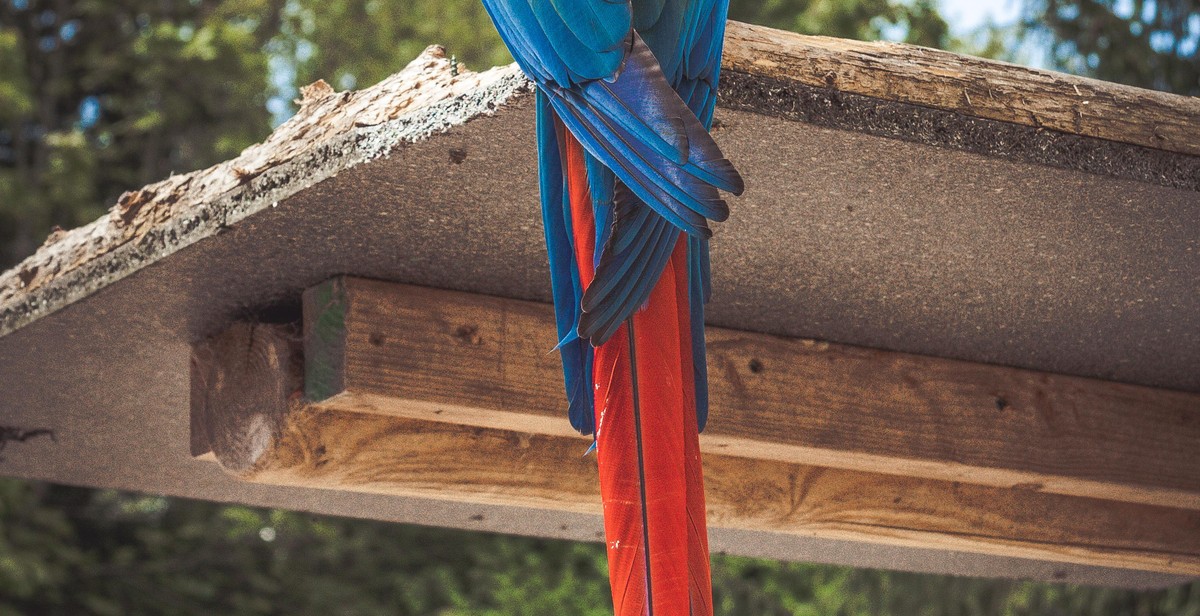How to Train Your Parrot: Step-by-Step Guide to Teaching Tricks and Commands
Parrots are intelligent and social birds that make great pets. Training your parrot can be a fun and rewarding experience for both you and your feathered friend. Not only will it provide mental stimulation for your parrot, but it will also strengthen your bond and improve communication between you and your pet.
Why Train Your Parrot?
Parrots are highly intelligent birds that require mental and physical stimulation to stay healthy and happy. Training your parrot provides a great way to engage their minds and keep them occupied. It also helps to establish a bond of trust and respect between you and your pet.
Training your parrot can also be beneficial in emergency situations. For example, if your parrot flies out of its cage or gets lost, having a well-trained bird that responds to commands can make it easier to retrieve them safely.
What You Will Need
- A parrot
- A training area
- Treats
- Patience and consistency
Step-by-Step Guide to Teaching Tricks and Commands
Training your parrot can be broken down into a few simple steps:
- Establish a training area
- Choose a command or trick to teach
- Use positive reinforcement and treats to encourage desired behavior
- Repeat the training sessions regularly
- Gradually increase the difficulty of the tricks and commands
With patience and consistency, you can train your parrot to do all sorts of fun and useful things, from stepping up onto your hand to saying hello on command. So, grab some treats and get started!
Understanding Your Parrot’s Behavior
Training your parrot requires a deep understanding of their behavior. Parrots are highly intelligent birds with complex social structures and personalities. To train your parrot effectively, you need to establish a strong bond with your parrot and recognize their body language. Positive reinforcement is also crucial in shaping your parrot’s behavior.
The Importance of Positive Reinforcement
Positive reinforcement is a training technique that involves rewarding your parrot for exhibiting desirable behavior. It is a highly effective method for shaping your parrot’s behavior and strengthening your bond with them. Positive reinforcement can include verbal praise, treats, or toys that your parrot enjoys.
When using positive reinforcement, it is essential to reward your parrot immediately after they exhibit the desired behavior. This will help them associate the behavior with the reward and encourage them to repeat it in the future.
Recognizing and Responding to Body Language
Parrots communicate through their body language, and it is essential to recognize and respond to their signals. Some common body language cues include fluffed feathers, dilated pupils, and raised wings. These signals can indicate your parrot’s mood, level of comfort, and stress.
By understanding your parrot’s body language, you can adjust your training methods to suit their needs. For example, if your parrot appears stressed, you may need to take a break from training and provide them with some quiet time.
Establishing Trust and Bonding with Your Parrot
Establishing trust and bonding with your parrot is crucial for successful training. To build trust, spend time with your parrot every day, offering them treats and toys, and talking to them in a calm and soothing voice. Avoid sudden movements or loud noises that can startle your parrot.
As you spend time with your parrot, they will become more comfortable around you, and you can begin to establish a bond. A strong bond with your parrot will make training easier and more enjoyable for both you and your bird.

Teaching Basic Commands
Teaching basic commands to your parrot is an essential part of its training. Basic commands such as ‘up’ and ‘down’ will help you communicate with your parrot, and it will make your parrot more obedient. Here are three simple steps to help you teach your parrot basic commands:
Step 1: Target Training
The first step in teaching basic commands to your parrot is target training. Target training involves teaching your parrot to touch a target stick with its beak. This technique is an effective way to teach your parrot new behaviors and commands.
To start target training, hold a target stick in front of your parrot’s beak. When your parrot touches the stick with its beak, reward it with a treat and praise. Repeat this process several times until your parrot consistently touches the target stick with its beak.
Step 2: Teaching ‘Up’ Command
The ‘up’ command is one of the most basic commands you can teach your parrot. To teach your parrot the ‘up’ command, start by holding a treat above your parrot’s head. When your parrot reaches up to get the treat, say ‘up’ and reward your parrot with the treat. Repeat this process several times until your parrot associates the word ‘up’ with the action of reaching up.
Step 3: Teaching ‘Down’ Command
The ‘down’ command is the opposite of the ‘up’ command. To teach your parrot the ‘down’ command, hold a treat below your parrot’s chest. When your parrot reaches down to get the treat, say ‘down’ and reward your parrot with the treat. Repeat this process several times until your parrot associates the word ‘down’ with the action of reaching down.
By following these three simple steps, you can teach your parrot basic commands that will help you communicate with it and make it more obedient. Remember to be patient and consistent in your training, and always reward your parrot for good behavior.

Advanced Tricks and Commands
Once your parrot has mastered the basic commands, it’s time to move on to more advanced tricks and commands. These commands will not only impress your friends and family but also provide mental stimulation for your parrot.
Step 1: Teaching ‘Wave’ Command
The ‘Wave’ command is a fun trick that is easy to teach your parrot. Here are the steps:
- Hold a treat in front of your parrot’s face and say ‘Wave’.
- Move the treat slightly away from your parrot’s face, encouraging them to lift their foot.
- Once your parrot lifts their foot, give them the treat and praise them.
- Repeat the process several times until your parrot lifts their foot on command without the treat.
Step 2: Teaching ‘Turn Around’ Command
The ‘Turn Around’ command is another fun trick that is easy to teach your parrot. Here are the steps:
- Hold a treat in front of your parrot’s face and say ‘Turn Around’.
- Move the treat in a circular motion, encouraging your parrot to follow it with their head.
- Once your parrot completes the circle, give them the treat and praise them.
- Repeat the process several times until your parrot completes the circle on command without the treat.
Step 3: Teaching ‘Speak’ Command
The ‘Speak’ command is a bit more challenging than the previous commands, but it is still possible to teach your parrot. Here are the steps:
- Wait for your parrot to make a noise, such as a chirp or squawk.
- Say ‘Speak’ and reward your parrot with a treat.
- Repeat the process several times, gradually increasing the amount of noise your parrot makes before saying ‘Speak’.
- Eventually, your parrot will associate the command ‘Speak’ with making noise and will do it on command.
| Command | Description |
|---|---|
| Wave | Parrot lifts their foot in a waving motion on command. |
| Turn Around | Parrot turns in a circle on command. |
| Speak | Parrot makes noise on command. |
By teaching these advanced tricks and commands, you can provide your parrot with mental stimulation and strengthen the bond between you and your feathered friend.

Common Training Challenges and Solutions
Biting and Aggressive Behavior
One of the most common training challenges with parrots is biting and aggressive behavior. This can be a major issue, especially if you have children or other pets in the home. The first step in addressing this issue is to understand why your parrot is behaving aggressively. Some common reasons include fear, territoriality, and lack of socialization.
To address biting and aggressive behavior, it is important to establish trust and a positive relationship with your parrot. Spend time with your bird every day, and offer treats and positive reinforcement for good behavior. It may also be helpful to consult with a professional trainer or behaviorist who can offer personalized advice and training techniques.
Screaming and Vocalization
Another common training challenge with parrots is excessive screaming and vocalization. While some level of vocalization is natural and healthy for parrots, excessive noise can be disturbing to you and your neighbors. The key to addressing this issue is to understand why your bird is screaming.
Parrots may scream for a variety of reasons, including boredom, attention-seeking behavior, and anxiety. To address excessive vocalization, it is important to provide your parrot with plenty of mental and physical stimulation. Offer toys, puzzles, and other activities that will keep your bird engaged and entertained. You may also want to consider training your bird to use specific vocalizations for specific behaviors, such as a whistle for coming when called.
Destructive Behavior
Parrots are known for their destructive tendencies, and it is not uncommon for them to chew on furniture, walls, and other household items. To address destructive behavior, it is important to provide your bird with plenty of safe, chewable toys and objects. You may also need to supervise your bird more closely and limit their access to areas of the home where they are likely to cause damage.
It is also important to provide your parrot with plenty of mental and physical stimulation to prevent boredom and frustration. Offer plenty of opportunities for exercise, play, and socialization, and consider training your bird to perform specific behaviors or tricks to keep them engaged and mentally stimulated.
| Training Challenge | Solution |
|---|---|
| Biting and Aggressive Behavior | Establish trust, positive reinforcement, and consult with a professional trainer or behaviorist |
| Screaming and Vocalization | Provide mental and physical stimulation, train specific vocalizations for specific behaviors |
| Destructive Behavior | Provide safe chewable toys, supervise more closely, provide mental and physical stimulation |
Conclusion
Training your parrot can be a fun and rewarding experience for both you and your feathered friend. By following the step-by-step guide outlined in this article, you can teach your parrot a variety of tricks and commands that will help keep them mentally stimulated and engaged.
Tips for Successful Parrot Training
- Be patient and consistent with your training
- Use positive reinforcement techniques, such as treats and praise
- Keep training sessions short and frequent
- Pay attention to your parrot’s body language and adjust your training accordingly
- Always end training sessions on a positive note
Common Parrot Training Mistakes to Avoid
- Using punishment or negative reinforcement
- Expecting too much too soon
- Ignoring your parrot’s body language and cues
- Skipping steps in the training process
- Not providing enough mental and physical stimulation outside of training sessions
Remember, every parrot is unique and will learn at their own pace. With patience, consistency, and positive reinforcement, you can help your parrot develop new skills and strengthen the bond between you.
| Key Takeaways: |
| Training your parrot takes time and patience, but can be a rewarding experience. |
| Use positive reinforcement techniques and pay attention to your parrot’s body language. |
| Avoid common training mistakes, such as using punishment or skipping steps in the training process. |
| Remember to provide your parrot with plenty of mental and physical stimulation outside of training sessions. |
